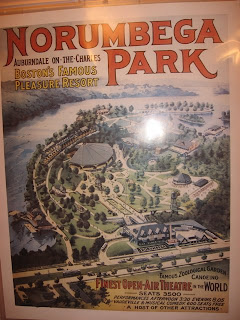 Recently I visited an exhibit at the Newton MA History Museum entitled "Romance and Recreation by the River".
Recently I visited an exhibit at the Newton MA History Museum entitled "Romance and Recreation by the River".Norumbega was an incredible amusement park in Newton that opened in June, 1897, and it was a popular destination for Boston area families and young people in 1905. Each year from April to October more than a half million people visited the park.
According to the late Robert Pollock, a long-time resident of Newton who used to work on the midway at Norumbega:
The park featured various types of recreation: a merry-go-round, canoes, huge wooden swings, free band concerts, extensive picnic grounds, and the largest zoo in New England. In addition, the park had a superlative restaurant, a penny arcade, an electric fountain with brightly-colored spotlights playing over great geysers of water, and a vaudeville theatre. The 15-cent round trip fare from Lake Street included admission to the park, and the ride out Commonwealth Avenue on the open trolleys became very popular with people from throughout the greater Boston area. Electricity for Norumbega's lighting, fountain, and carousel was provided by the same 600 volts of direct current used to power the trolleys.
The park featured various types of recreation: a merry-go-round, canoes, huge wooden swings, free band concerts, extensive picnic grounds, and the largest zoo in New England. In addition, the park had a superlative restaurant, a penny arcade, an electric fountain with brightly-colored spotlights playing over great geysers of water, and a vaudeville theatre. The 15-cent round trip fare from Lake Street included admission to the park, and the ride out Commonwealth Avenue on the open trolleys became very popular with people from throughout the greater Boston area. Electricity for Norumbega's lighting, fountain, and carousel was provided by the same 600 volts of direct current used to power the trolleys.
As happened with areas along train and trolley lines in other parts of the country at about the same time, the park had been built by the street railway company to attract more business to the trolley line, and it was extremely successful.
 In a previous post, I wrote about the "problem" of kissing in canoes on the river at Norumbega, which came to a head during the summer of 1905. It was said that there were a million dollars worth of kisses every weekend on the river (based on the possibility of a $20 fine)! And the song Down by The Riverside, which garnered new lyrics in 1902, was inspired by the activities along the river. (I also remember a popular recording of this song from the 1950s. The original music and refrain were, of course, based on an old Negro spiritual.)[1]
In a previous post, I wrote about the "problem" of kissing in canoes on the river at Norumbega, which came to a head during the summer of 1905. It was said that there were a million dollars worth of kisses every weekend on the river (based on the possibility of a $20 fine)! And the song Down by The Riverside, which garnered new lyrics in 1902, was inspired by the activities along the river. (I also remember a popular recording of this song from the 1950s. The original music and refrain were, of course, based on an old Negro spiritual.)[1]The theatre at Norumbega had been open air until 1904, when a roof was added. Vaudeville acts were featured twice a day, six days a week, with religious and inspirational music on Sundays.
There was also a "Women's Cottage" at the park, offering cots, cribs, sofas, and changing tables to facilitate the ability of women to visit the park with their children.
The park suffered a slow decline through the 1930s and 1940s. Trolley service to the park ended in 1930. The ferris wheel was damaged by the famous 1938 hurricane, and never reopened. In 1941, all the animals (except the bears) were sold off. And in 1965-1966, three fires destroyed the Totem Pole Ballroom, the restaurant, and the boat house.
Interestingly enough, visiting this exhibit reminded me that my Newton college had held a dance at the Totem Pole that I attended--probably in the spring of 1965. I wasn't paying enough attention to local news to learn that Norumbega received its final death blow in November, 1965, during my senior year.
Illustration Credits and References
[1] The lyrics of the popular song as I knew it in the 50s are shown below. Apparently there is some confusion about how much of these lyrics were part of the 1902 version:
I met my little bright-eyed doll
Down by the riverside (3x)
I met my little bright-eyed doll
Down by the riverside
Down by the riverside
I asked her for a little kiss
Down by the riverside (3x)
I asked her for a little kiss
Down by the riverside
Down by the riverside
She said "Have patience little man
I'm sure you'll understand
I hardly know your name"
I said "If I can have my way
Maybe some sweet day
My name and yours will be the same"
I wed that little bright-eyed doll
Down by the riverside (3x)
Well I wed that little bright-eyed doll
Down by the riverside
Down by the riverside
The color photos of sheet music and posters at the beginning of this post were taken at the Newton History Museum exhibit. The first illustration is from a 1905 poster. You can see cars running along the road which crosses the illustration left to right; trolleys are running down the median. The river runs to the left of the road that starts at the bottom and heads towards the top of the image. The boathouse is at the lower left.